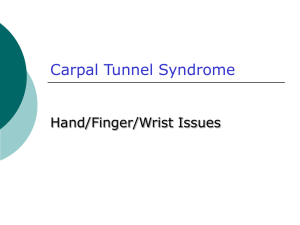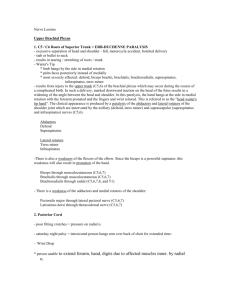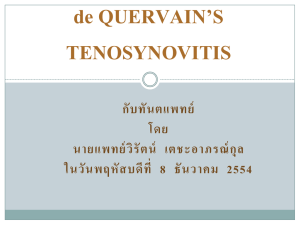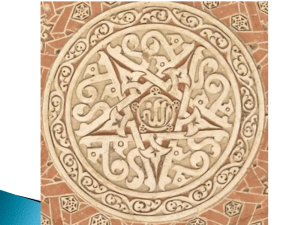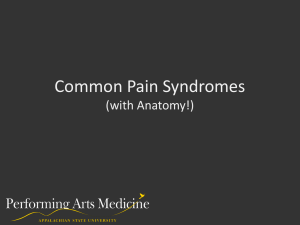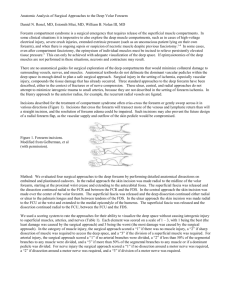Radial nerve palsy
advertisement
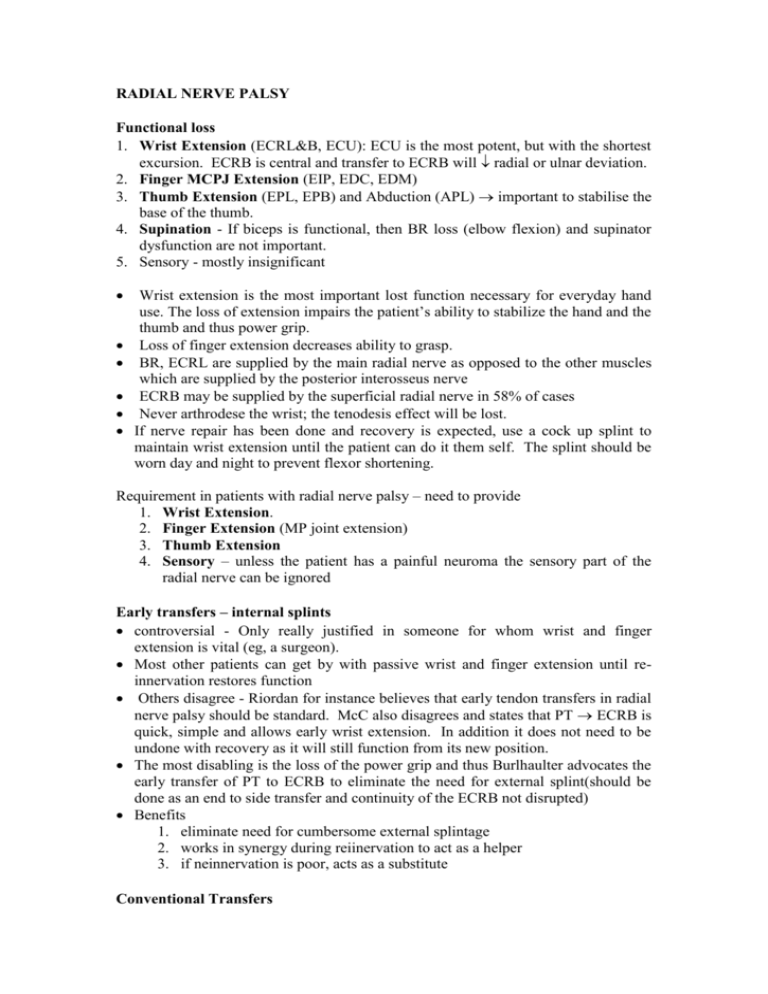
RADIAL NERVE PALSY Functional loss 1. Wrist Extension (ECRL&B, ECU): ECU is the most potent, but with the shortest excursion. ECRB is central and transfer to ECRB will radial or ulnar deviation. 2. Finger MCPJ Extension (EIP, EDC, EDM) 3. Thumb Extension (EPL, EPB) and Abduction (APL) important to stabilise the base of the thumb. 4. Supination - If biceps is functional, then BR loss (elbow flexion) and supinator dysfunction are not important. 5. Sensory - mostly insignificant Wrist extension is the most important lost function necessary for everyday hand use. The loss of extension impairs the patient’s ability to stabilize the hand and the thumb and thus power grip. Loss of finger extension decreases ability to grasp. BR, ECRL are supplied by the main radial nerve as opposed to the other muscles which are supplied by the posterior interosseus nerve ECRB may be supplied by the superficial radial nerve in 58% of cases Never arthrodese the wrist; the tenodesis effect will be lost. If nerve repair has been done and recovery is expected, use a cock up splint to maintain wrist extension until the patient can do it them self. The splint should be worn day and night to prevent flexor shortening. Requirement in patients with radial nerve palsy – need to provide 1. Wrist Extension. 2. Finger Extension (MP joint extension) 3. Thumb Extension 4. Sensory – unless the patient has a painful neuroma the sensory part of the radial nerve can be ignored Early transfers – internal splints controversial - Only really justified in someone for whom wrist and finger extension is vital (eg, a surgeon). Most other patients can get by with passive wrist and finger extension until reinnervation restores function Others disagree - Riordan for instance believes that early tendon transfers in radial nerve palsy should be standard. McC also disagrees and states that PT ECRB is quick, simple and allows early wrist extension. In addition it does not need to be undone with recovery as it will still function from its new position. The most disabling is the loss of the power grip and thus Burlhaulter advocates the early transfer of PT to ECRB to eliminate the need for external splint(should be done as an end to side transfer and continuity of the ECRB not disrupted) Benefits 1. eliminate need for cumbersome external splintage 2. works in synergy during reiinervation to act as a helper 3. if neinnervation is poor, acts as a substitute Conventional Transfers FCU Transfer Wrist extension o Pronator teres(PT)ECRB Thumb extension o PLEPL (Rerouted EPL)(If PL absent, use FDS from MF.) Finger extension o FCUEDC o Controversial: Boyes feels FCU is 1. too strong and excursion too short to the finger extension 2. functions as a prime ulna stabiliser that should not be sacrificed and 3. wrist flexors excursion is too short to allow simultaneous wrist dorsiflexion and finger extension. FDS has more excursion and this is ideal Because of this, best to use Superficialis transfer or FCR transfer Boyes Transfer Wrist Extension o PT to ECRL and ECRB Finger Extension o FDS MF to EDC (via interosseous membrane) Thumb Extension o FDS RF to EIP and EPL (via interosseous membrane) o FCR to APL and EPB Wrist extension PT ECRB: This is a good, straight-line, easy to do, efficient transfer and the one favoured by most surgeons today (Murray, 1919). Good with respect to tension, easy to re-educate, needs minimal dissection, continues its original function. PT tendon tends to be short to reach ECRB, therefore it can be taken with some periosteum to give an extra 1-1.5 cm. To prevent re-attachment to the raw area of bone, it should be routed superficial to BR. Some muscle fibres of ECRB can be retracted to expose the tendon slightly more proximally. These can then be sutured (tubed) over the suture line. Fixation is done with the wrist in about 45o of extension. Others that have been used in the past: i. FCU (Weitz, 1916): plenty of tension, but out of phase ii. FCR (Henry, 1916): Acceptable tension and excursion, but out of phase iii. FDS (Biesalski and Meyer, 1916): Better reserved for finger extension Thumb extension APB will provide a variable degree of thumb IPJ extension. Since the intrinsics are present, usually all that needs replacing is EPL. PL (Pennell, 1919) is the best motor if it present. If PL absent, can use FDS to M (or R). EPL is divided at the musculo-tendinous junction and removed from its tunnel so that a more direct pull is obtained and so that there is an element of abduction. It is sutured end to end or with a weave to PL. Replacement of APL Thumb normally has 3 radial motors (EPL, EPB & APL) - replacement with a single TT is usually not all that successful. APL is important in drawing the thumb metacarpal out for circle pinch. The Th adductor is a powerful muscle drawing the MC in and therefore if APL replacement is considered, a strong motor is needed. APL also flexes the wrist and radially deviates it. FCR is therefore the best replacement for APL as it has these 2 actions and a similar strength to APL. Replacement of APL, however, is not always required. Another solution is to tenodese APL to the radius especially if ulnar deviation is associated with wrist flexion. It is not a procedure to be recommended for simple radial nerve palsy as it renders the FCU captive to Th MC abduction Finger extension Lumbricals and interossei will extend the fingers at the IPJ. No consensus on the best way to achieve finger extension. Options: 1. Classically: Jones transfer (1916): FCU around ulnar border of wrist EDC. FCU must be well mobilised for good excursion. FCU is the strongest forearm flexor and well able to the job, but it has 3 problems: i. FCU is an important ulnar stabiliser and deviator of the wrist, an important function for many everyday activities. ii. Its excursion is slightly limited, thus full finger extension is not achieved unless the wrist is flexed. iii. May create a bulge at the ulnar aspect of the wrist 2. Tsuge partly eliminates the problem by re-routing FCU through the interosseous membrane. This allows a more direct pull. The operation is more complex and only solves the last 2 problems. 3. FCR around the radial border of the wrist to MF and RF of EDC. IF needs to be attached to MF and LF to RF tendons (length) which creates a lot of scarring in the area of the extensor retinaculum. Despite this disadvantage, using FCR has other advantages: a) tension and excursion are better than with FCU b) FCR is missed less than FCU c) it makes less of a bulge than FCU Wikus likes FCR to EDC and calls it a Brand transfer, but Brand (in McC) prefers: 4. FDS to M (or R), through the interosseus membrane, to EDC. Sutured distal to extensor retinaculum and therefore fewer adhesions. Allows full and ample finger extension. According to Brand, this is the muscle of choice. Brand therefore recommends: i. If PL present EPL; and FDS to M EDC to all 4 fingers. ii. If PL absent, FDS to M EPL and FDS to R EDC of all 4 fingers. FCU Transfer Incisions 1. Transect FCU tendon 2. mobilise FCU muscle belly up to its neurovascular bundle 3. Free up insertion of PT with long strip of periosteum PT is passed superficial to BR and sutured end to side to ECRB FCU must be freed extensively to create a direct line of pull from its origin to attachment to EDC just proximal to dorsal retinaculum Muscle belly distally may need to be thinned to reduce bulk May be passed through interosseus membrane EDC may be divided for end-end repair and a more direct line of pull Most do not include EDM for fear of creating excessive tension of the little finger EPL divided at the musculotendinous junction and rerouted out of dorsal compartment Transfer creates abduction and extension force on thumb Intraoperative Problems 1. Excessive radial deviation a. Due to removing FCU b. Options i. Avoid by using superficialis transfer ii. Centralise the insertion of ECRL (to3rd and 4th metacarpus) 2. Absence of Palmaris Longus a. Include EPL into FCU to EDC transfer b. FDS MF/RF c. BR (if injury at PIN) 3. Bowstringing EPL a. Hook EPL around APL insertion Superficialis Transfer Incisions 1. Long forearm radial incision a. Detach PT insertion b. Suture to both ECRL and ECRB – some prefer to suture only to ECRB due to potential for adhesions between the 2 tendons and different moment arms) 2. Transverse incision distal palm to harvest FDS – divided proximal to chiasma 3. Distal forearm a. 1x2 cm opening created in interooseous membrane protecting both anterior and posterior interosseous vessels b. FDS MF routed on the radial side of FDP and FDS RF on ulnar side c. Beware kinking of median nerve d. Some prefer to pass around the radial or ulnar border in an effort to avoid tendon adherence 4. J shape incision dorsum of distal forearm over extensor retinaculum a. FDS MF to EIP and EPL b. FDS RF to EDC c. EDM not included 5. Transverse incision at base of thumb a. FCR divided and sutured into APL and EPB FCR Transfer Incisions 1. Long forearm radial incision between FCR and PL a. FCR, PT and PL detached b. FCR freed up as far as possible proximally c. Passed around radial border. Tsuge passes it through the interosseous membrane for a straighter line of pull 2. Dorsal longitudinal incision over extensor retinaculum a. Sutured to EDC end to side or end-end (Brand) b. PL to EPL (if PL absent, than EPL is attached to FCR) c. PT to ECRB

